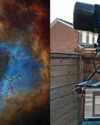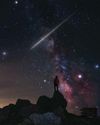
There are few things quite as captivating as seeing the rings of Saturn for the first time. This month, on 27 August, the planet will reach opposition, when it lies directly opposite the Sun relative to Earth and will be at its brightest and highest, clearly visible at magnitude +0.4 and reaching around 25° in altitude from the UK. You can find Saturn in Aquarius this year and into 2024.
At the start of August, Saturn will be at its best after midnight. It rises earlier as the month goes on, becoming more of an evening object and by opposition is up all night. It will be relatively low, so we'll be looking at Saturn through more of our own atmosphere. Normally, this isn't ideal for imaging, but you'll want to catch the planet this year, as over the next few years Saturn's rings are going to disappear.
Don't worry! They'll be back. It's just that the apparent tilt of Saturn's rings varies over its 29-year orbit. This year, the rings are tilted down at a 9° angle at opposition, but next year they'll be just 3.7 and by 2025, they'll disappear into an almost imperceptible line as Earth views them edge on. After that they'll become increasingly visible as the southern pole of the planet tips towards us, reaching their maximum inclination of 27° in 2032. In a way, the rings being less tilted is an opportunity as you can watch the rapidly orbiting moons more easily.
Personally, I love to image Saturn, capturing the planet's bands on camera and tracking how the moons move around it. Why not make 2023 the year you get started in planetary photography and record the rings before they go? Doing so is now easier than ever, and it's even possible to capture the planets under skies with a lot of light pollution. I encourage you to have a go- the results can be extremely satisfying.
This story is from the August 2023 edition of BBC Sky at Night Magazine.
Start your 7-day Magzter GOLD free trial to access thousands of curated premium stories, and 9,000+ magazines and newspapers.
Already a subscriber ? Sign In
This story is from the August 2023 edition of BBC Sky at Night Magazine.
Start your 7-day Magzter GOLD free trial to access thousands of curated premium stories, and 9,000+ magazines and newspapers.
Already a subscriber? Sign In

Putting cosmic rays to work
These penetrating interstellar particles have applications from astronomy to archaeology

Set up your first imaging sequence
How to automate and coordinate your gear over multiple nights of imaging

The Universe without gravity
Life with no gravity might sound a fun idea, but as Govert Schilling explains, shutting off this pivotalforce would spell disaster for Earth and beyond

How to blend images taken with different camera setups
Combine data captured at varied focal lengths to create rich, deep images

INSIDE THE SKY AT NIGHT
Back in September 2021, The Sky at Night show spoke to Carly Howett about NASA's then upcoming Lucy mission. As the spacecraft now approaches its main targets - the Trojan asteroids - we check in with her to see how the mission is going

The science of SCI-FI
We love a good sci-fi film, but do they get the science right? Amy Arthur picks six of the big mistakes made in space films

Seeing in a new light
It's National Astronomy Week this month, so take a tip from Mark Westmoquette and let mindful stargazing change your perspective on your life and problems

What to do if you find a meteorite
Ever come across an unusual rock and wondered if it's a meteorite? Mark McIntyre explains how to tell if that stone really is a fragment from outer space

GEAR
Charlotte Daniels rounds up the latest astronomical accessories

Q&A WITH A STELLAR ECLIPSE SPECIALIST
Many stars are gravitationally locked inside multi-star systems, but a rare new triple-star system has set a new record for how cosy these clusters can get